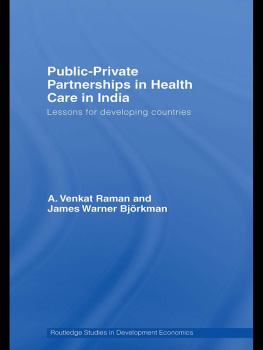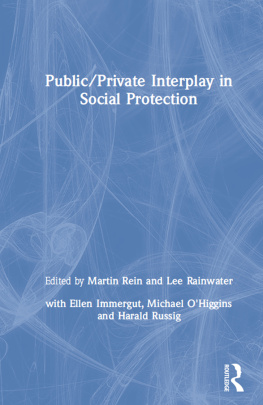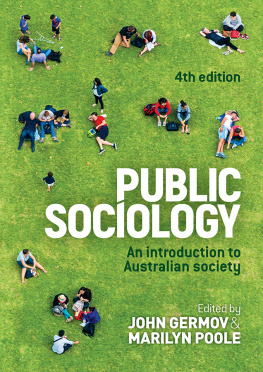ROUTLEDGE LIBRARY EDITIONS: BRITISH SOCIOLOGICAL ASSOCIATION
Volume 21
PRIVATE RISKS AND PUBLIC DANGERS
PRIVATE RISKS AND PUBLIC DANGERS
Edited by
SUE SCOTT, GARETH WILLIAMS, STEPHEN PLATT AND HILARY THOMAS
First published in 1992 by Avebury Ashgate Publishing Limited
This edition first published in 2018
by Routledge
2 Park Square, Milton Park, Abingdon, Oxon OX14 4RN
and by Routledge
711 Third Avenue, New York, NY 10017
Routledge is an imprint of the Taylor & Francis Group, an informa business
1992 British Sociological Association
All rights reserved. No part of this book may be reprinted or reproduced or utilised in any form or by any electronic, mechanical, or other means, now known or hereafter invented, including photocopying and recording, or in any information storage or retrieval system, without permission in writing from the publishers.
Trademark notice: Product or corporate names may be trademarks or registered trademarks, and are used only for identification and explanation without intent to infringe.
British Library Cataloguing in Publication Data
A catalogue record for this book is available from the British Library
ISBN: 978-1-138-49942-3 (Set)
ISBN: 978-1-351-01463-2 (Set) (ebk)
ISBN: 978-0-8153-4869-6 (Volume 21) (hbk)
ISBN: 978-1-351-16616-4 (Volume 21) (ebk)
Publishers Note
The publisher has gone to great lengths to ensure the quality of this reprint but points out that some imperfections in the original copies may be apparent.
Disclaimer
The publisher has made every effort to trace copyright holders and would welcome correspondence from those they have been unable to trace.
Private Risks and Public Dangers
Edited by
SUE SCOTT
GARETH WILLIAMS
STEPHEN PLATT
HILARY THOMAS
Explorations in Sociology No. 43
British Sociological Association 1992
All rights reserved. No part of this publication may be reproduced, stored in a retrieval system, or transmitted in any form or by any means, electronic, mechanical, photocopying, recording or otherwise without the prior permission of the publisher.
Published by
Avebury
Ashgate Publishing Limited
Gower House
Croft Road
Aldershot
Hants GUI 1 3HR
England
Ashgate Publishing Company
Old Post Road
Brookfield
Vermont 05036
USA
A CIP catalogue record for this book is available from the British Library and the US Library of Congress.
ISBN 1 85628 368 2
Details of other volumes in the Explorations in Sociology series are available from:
British Sociological Association Publications
Unit 3G, Mountjoy Research Centre
Stockton Road
Durham DH1 3SW
Printed and Bound in Great Britain by
Athenaeum Press Ltd., Newcastle upon Tyne.
Contents
Ronald Frankenberg
Sue Scott and Gareth Williams
Gavin Kendall and Gary Wickham
Judy Green
Richard Freeman
Vikki Bell
David Clark and David Morgan
Charlie Davison, Stephen Frankel and George Davey Smith
Maureen McNeil and Jacquelyn Litt
Graham Hart, Ray Fitzpatrick, Jill Dawson, John McLean and Mary Boulton
Joel Richman and Tom Mason
Evan Willis
Helen Roberts, Susan J Smith and Michelle Lloyd
Many people have supported the production of this volume, but our main thanks go to two people: Anne Dix, the British Sociological Associations Administrative Secretary whose knowledge, organizational skill and support made organizing the BSAs 1991 conference a much more pleasant experience than it would otherwise have been; and Nick Dalziel, the BSAs Publications Officer, for the hard work he has put into negotiating the publication of this volume.
Ronald Frankenberg
Brunei and Keele Universities
And instead of being angry, I began to giggle at his absurdity, at the X-ray sisters cruelty, and at my own helplessness. The three conditions moved together to make a fantastic picture in my mind. It was as if some gigantic buffoonery had descended upon the whole earth.
I laughed for all the horrors I could imagine existing at that moment; for all the terrors and despairs and tortures and madnesses. I laughed to think of the strange things that were happening to human bodies all over the world. Some were feasting, some were locked in dungeon cells, some were copulating, some were singing, some were having babies, some were starving, some were weeping, some were having Turkish baths, and some were being torn to bits. I thought of the infinite number of postures, expressions, gestures and functions of the body; and these were the funniest thoughts of all. (Denton Welch 1985 (1950) A Voice Through a Cloud, London: Penguin Books )
The general metaphor for standing aloof, watching from a distance, is significantly clinical detachment. The clinic is, as Foucault (1973) and Armstrong (1983) have taught us, the place increasingly remote from lived life, where biological life is maintained by experts who impose their will upon our bodies and our minds. But is it detached from danger, remote from risk. It is our cultural duty to be grateful for, and our social duty to resent, their attentions. We recognize their distinctions as simultaneously salutary and dangerous, especially those between what can be observed through enhanced sight and what can be felt through enhanced sensitivity of feeling and emotions.
In the past, Uta Gerhardt and myself have severally preached that the point of intersection of the sociology of health and illness with general sociology was the contempt of experts for the mass which imperialism and Fabianism had synergistically engendered (sic). Significantly on this grander, dare one say post-modern, occasion, we both started from Auschwitz. She told us that progress deserted culture there; I suggested that on the contrary, following Bauman (1989) and the film Shoah, that Auschwitz was the reductio ad absurdum of enlightenment modernist doctrine (Spiegelman 1987 and 1992). The Holocaust and the murderous abuses of Stalinism were triumphs of disembodied rationalism. Jewish and Kulak, gypsy and gay, lame and handicapped are characteristics seen as undesirable and to be removed in as efficient a way as possible; the ultimate solution is the ultimate technological fix. Some even describe them metaphorically as cancerous on the body social or the body politic. The fact that they are characteristics of living people, bodies personal, who are simultaneously destroyed is less than relevant to such thinking.
Romanyshyn (1989) contrasts for us a view of Florence before the invention of perspective, with one painted shortly afterwards. In the first, we feel that we might well bump into the walls or into fellow human beings. We can almost smell what Italians call in contrast to the odour of sanctity,













